Top News
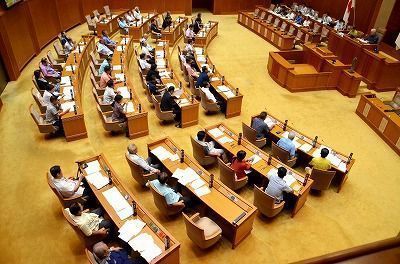
October 16, 2017 Ryukyu Shimpo Digital Edition
In the wake of the crash landing and fire of a U.S. military CH53E helicopter in the Takae district of Higashi Village, the Okinawa Prefectural Assembly unanimously passed protest resolutions and official opinion statements in the final session of the September regular meetings October 16. The resolutions demanded a ban on the use of helipads in the Northern Training Area (NTA), and a stoppage of any flight exercises over private land or water resources.
The official opinion statement was submitted to the Japanese Prime Minister, Foreign Minister, Defense Minister, and Minister of State for Okinawa. The resolution was submitted to the American ambassador to Japan, the commander of U.S. Forces in Japan, the Okinawa Area Coordinator, the U.S. Consulate General Naha, and the commander of the 3rd Marine Expeditionary Force. The Assembly also plan to engage in calls to protest against the U.S. military in Okinawa and to send the resolution and opinion statement to similar parties abroad.
The same day, the Prefectural Assembly also unanimously passed a resolution and opinion statement protesting parachute training at the Katena Air Base. The resolution and opinion statement claim that the parachute training was moved to Ie Shima Airfield in the Special Action Committee on Okinawa (SACO) agreement, and that training exercises outside of Ie Shima are, “In disregard of the SACO agreement, and that they cannot sanction any activity not related to the improvement of base functions.”
Additionally, after the September 29 emergency-landing of an MV-22 Osprey belonging to MCAS Futenma at the New Ishigaki Airport, the Assembly also passed a protest resolution and official opinion statement proposed by the ruling coalition. The resolution demanded the decommissioning of the Ospreys, the end of operations at MCAS Futenma within five years, and the withdrawal of the Marines from Okinawa.
Meanwhile the Liberal Democratic Party-led coalition commented on the name of the resolution, titled “[Resolution on the] Emergency Landing Accident,” stating that, “an emergency landing is not an accident,” and that while they agree with the sentiment of the resolution, they could not agree to the demands to decommission the Ospreys and withdrawal of the Marines, and walked out of the vote. The resolutions were then passed unanimously without the participation of the LDP.
(English translation by T&CT and Sam Grieb)
Go to Japanese
October 12, 2017 Ryukyu Shimpo
A CH-53 transport helicopter belonging to U.S. Marine Corps Air Station Futenma made an unplanned landing and then burst into flames on civilian land along route 70 in Higashi Village.
The nearest civilian homes were a mere 200 meters from the crash. One wrong move and the incident could have been a terrible tragedy.
In 2004, a helicopter of the same type as that which caused the recent accident crashed into Okinawa International University in Ginowan City.
Last December, less than one year ago, an MV-22 Osprey vertical takeoff and landing transport aircraft crashed in Abu, Nago City.
Flights of aircraft of the same type as that involved in the crash should be stopped until the cause of the accident is uncovered.
At the same time, the plan to build a new base to be used by U.S. Marine aircraft in Henoko, Nago City should be abandoned; use of the six helipads recently built in the U.S. military’s Northern Training Area should be prohibited; and the U.S. Marines, which continue to pose a threat to the lives and property of Okinawans, should leave Okinawa.
The place where the CH-53 helicopter went up in flames was a field near the Northern Training Area.
The Japanese and U.S. governments recently built six helipads positioned so as to surround the hamlet of Takae in Higashi Village as a condition for returning half of the land of the Northern Training Area.
During the construction, riot police were brought in from outside of Okinawa to forcefully suppress local residents protesting against the helipads.
At the ceremony last December to commemorate the return of half of the Northern Training Area, Chief Cabinet Secretary Yoshihide Suga emphasized that “This land return is the largest land return since Okinawa was returned to Japan; it entails the return of roughly 20% of U.S. military facilities in Okinawa and contributes greatly to the reduction of burden on Okinawa.”
However, as a result of Suga’s alleged “reduction of burden,” aircraft noise around Takae has increased and is having a grave impact on the lives of the residents there.
Now, a helicopter has burst into flames nearby. This is the reality. The “reduction of burden” of which the Abe administration speaks is really nothing but a “reinforcement of burden.”
The U.S. Marines announced that in the current accident, a fire occurred in the aircraft while in flight and it made an emergency landing.
But looking at pictures and video of the incident, it is hard to call it an “emergency landing.
” This wording is reminiscent of the information manipulation of calling last year’s crash in Abu, Nago City an “emergency water landing.”
Article 25 of the Japanese Constitution states, “All people shall have the right to maintain the minimum standards of wholesome and cultured living.
” Article 13 sets forth environmental rights (the right to the pursuit of happiness), and the preamble sets forth the right to live a peaceful existence without suffering danger to life or health.
Yet these rights continue to be flagrantly violated in Okinawa, even after its return to Japanese administration.
In June 1959, a jet crashed over Miyamori Elementary School in Ishikawa City (now Uruma City) in central Okinawa Island, claiming 17 lives, many of them schoolchildren.
In 1968, a B-52 strategic bomber, an aircraft used to attack Vietnam, crashed after failing to land at Kadena Air Base.
According to statistics compiled by the Okinawa Prefectural Government, there have been 48 crashes by U.S. military aircraft (as of the end of 2016) since Okinawa’s return to Japan in 1972.
There is no other prefecture in Japan where U.S. military aircraft crash at a rate of roughly one per year.
The excessive burden imposed by the construction of a new base in Henoko will be a major point of dispute in the upcoming House of Representatives election. We hope voters will make a thoughtful choice.
(English translation by T&CT and Sandi Aritza)
Go to Japanese
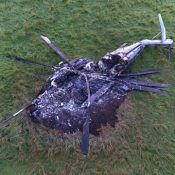
October 12, 2017 Ryukyu Shimpo
As of 7:00 a.m. on October 12, the charred remains of a U.S. Marine CH-53E heavy-lift transport helicopter belonging to the U.S. Marine Corp Futenma Air Station cast a miserable sight the night after it burst into flames due to a forced landing on pasture in Takae, Higashi Village.
U.S. military vehicles arrived at the site at around 1:20 a.m. on October 12. In the morning, U.S. soldiers walked around the wreckage of the burned-out helicopter.
A Ryukyu Shimpo photographer took photos of the helicopter using a drone. It was confirmed that the helicopter had been burned to black and the fire had spread to surrounding pastures. The cockpit was smouldering and burnt without a trace. It was confirmed that there were residential areas several hundred meters away.
(English translation by T&CT)
Go to Japanese
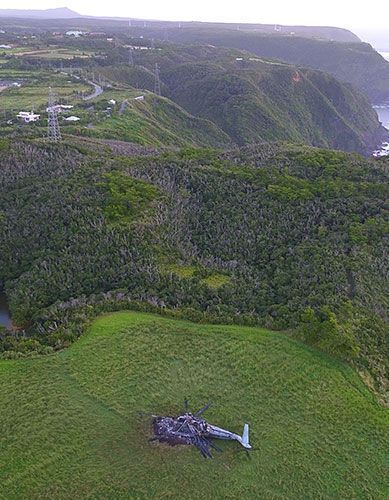
The burned-out CH-53E helicopter belonging to the U.S. Marine Corp Futenma Air Station and surrounding residential area can be seen at around 6:30 a.m. on October 12, in Takae, Higashi Village. (Photograph taken using a drone)

The CH-53E helicopter wreckage at around 6:35 a.m. on October 12, in Takae, Higashi Village. (Photograph taken using a drone)
;
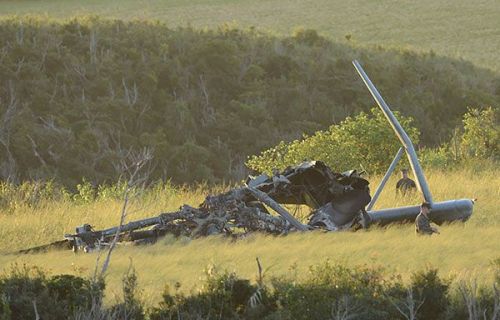
The CH-53E helicopter burned out at 6:45 a.m. on October 12, in Takae, Higashi Village. (Photograph taken using a drone)
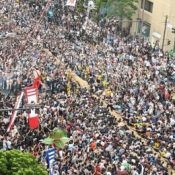
October 8, 2017 Ryukyu Shimpo online edition
On October 8, the 47th annual Naha Giant Tug-of-War Festival featuring the world’s largest festival rope took place at Kumoji intersection on National Route 58 in Naha City.
According to organizers about 270,000 participants and spectators crowded the streets, the air thick with enthusiasm.
Only about ten minutes from the commencement of the tug-of-war, the East team pulled the rope more than five meters their direction and won.
The total score through the years is now 15 wins for the East team, 14 wins for the West team, and 15 draws.
About 15,000 people shouted “hiyah” while pulling the 200-meter long, 40-ton rope back and forth.
In about 10 minutes as rain fell on-and-off, the winner of the tug-of-war was called.
The Office of the Conservation Society of the Naha Giant Tug-of-War, which was hosting the event, expressed surprise because it is unusual for the tug-of-war to be won or lost in such a short time.
The Giant Tug-of-War Festival is a traditional event that began in the 15th century. 1935 was the last festival for many years, until its restoration in 1971. In 1997, the large size of the rice straw festival rope was recognized in the Guinness Book of World Records.
(English translation by T&CT and Erin Jones)
Go to Japanese

October 13, 2017 Ryukyu Shimpo
In the wake of the recent U.S. military helicopter fire, Governor Takeshi Onaga paid a visit to the accident site in the Takae district of Higashi Village just after noon on October 12.
After observing the accident site, Onaga expressed his indignation to reporters, stating, “I am sad, frustrated, and angry.
” He also stressed that in regard to the military accidents which continue to occur despite protests from the Okinawa government, “This is a national disaster in that [the situation] is being forced upon Okinawa by the central Japanese government.”
In order to conduct a survey to see if radioactive or other hazardous materials are present at the site of the accident, the Okinawan Environmental Bureau requested entrance into the accident site, however it seems the request has not been granted.
As of 6:00 p.m. October 12, the survey has not been allowed to happen.
In 2004, there was also a helicopter crash at Okinawa International University, after which the Japanese and U.S. governments established guidelines for when a military vehicle crashes or makes an emergency landing outside of a U.S. military facility or designated area.
Okinawa requested the investigation in accordance with these guidelines, but it appears no such investigation is in sight.
Governor Takeshi indicated that with regards to Okinawa Police not being able to conduct an investigation due to the Japan-U.S. Status of Forces Agreement (SOFA), “The Japanese government has no say in the Japan-U.S. Joint Commission.
They can only ask to ‘Please make sure this does not happen again.’ It is about as effective as trying to nail down tofu.”
On the day of the accident, Higashi Village Mayor Morihisa Izu was unable to approach the site, but observed the wreckage from about 50 meters away at 9:00 a.m. the next morning, October 12. Izu was critical of the accident, saying, “Something that should never happen has occurred.” The site was also visited by the eight members of the village council (led by Toshiyuki Awa).
Shortly after returning to his office around 11 a.m., Mayor Ishu received a phone call from Japanese Defense Minister Itsunori Onodera, who expressed his apologies.
Ishu also said that Onodera explained, “Training exercises have been cancelled until we can determine the cause of the accident.”
(English translation by T&CT and Sam Grieb)
Go to Japanese
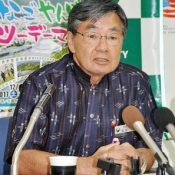
October 3, 2017 Ryukyu Shimpo Digital Edition
(Nago) At a regular press conference on the morning of October 3, Nago Mayor Susumu Inamine called on the Okinawa Defense Bureau to heed the Okinawa prefectural government’s administrative guidance instructing the Defense Bureau to halt construction of the new base at Henoko and discuss coral preservation measures with the prefectural government.
“They should stop the construction and conduct a survey to confirm the impact [on the coral],” said Inamine.
Regarding the fact that a majority of recently discovered colonies of rare coral were found dead, Inamine said, “They should stop the construction and explain why it happened.
” Regarding the impact of the construction on the coral, he said, “I think it can easily be assumed that the impact of the construction [played a role].”
Regarding the fact that the new Henoko base issue is not being treated as a major topic of dispute in the upcoming national House of Representatives election, Inamine said, “I have always said that all Japanese citizens should bear an equal burden.
Is the issue not being removed from discussion intentionally? I fear that indifference will spread.”
(English translation by T&CT and Sandi Aritza)
Go to Japanese
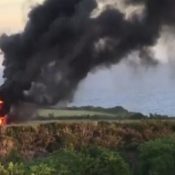
October 12, 2017 Ryukyu Shimpo
At around 5:20 p.m. on October 11, a U.S. Marine CH-53E heavy-lift transport helicopter belonging to the U.S. Marine Corp Futenma Air Station was forced to land on pasture in Takae near the U.S. military Northern Training Area, Higashi Village, Okinawa, and burst into flames.
The aircraft was wrecked.
According to the Kunigami district firefighting union headquarters, at about 5:35 p.m. local residents informed them that a U.S. military plane had crashed in Takae.
The U.S. Marine Corps in Okinawa announced that a U.S. Marine CH-53E had made an emergency landing after catching fire during a training flight.
Neither local residents nor the seven crew members were injured.
The accident occurred in civilian areas near the prefectural highway No. 70 and about 200 meters away from the nearest private residence.
Helicopters circled over the scene to put out the blaze, and Kunigami district firefighters sprayed water on the area.
It was confirmed that the fire was completely put out by 8:17 p.m.
(English translation by T&CT)
Go to Japanese
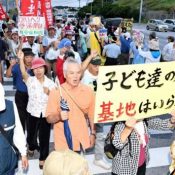
October 13, 2017 Ryukyu Shimpo
On October 12 the prefectural citizens’ organization opposing the relocation of U.S. bases within Okinawa and those involved in the Futenma noise lawsuits held an emergency gathering in Kitanakagusuku Village in front of the Ishihira gate to Camp Foster.
This gathering was a response to the CH-53 U.S. military helicopter that made an emergency landing on private property in Takae, Higashi Village, and went up in flames. More than 200 citizens rallied together, pumping their fists angrily into the air in protest of the accident.
Those who gathered to protest repeated U.S. military accidents were citizens who had just completed their day’s work.
Masahiko Nakandakari, co-representative of a liaison council opposing Takae helipad construction, raised the point: “Residents of Takae have long been burdened with apprehension while going about their lives. Yesterday’s accident was bound to happen. Let’s pull together and persevere.”
Hiroji Yamashiro, co-representative of the aforementioned prefectural citizen’s organization, addressed the crowd: “A dreadful accident has occurred. For the future, and for our children, let’s make our rage heard.”
Lead plaintiff Zenji Shimada of the Futenma noise lawsuits appealed: “This has already gone too far. What sort of world are we leaving for our children? We must make efforts more earnestly.”
Tsutomu Higa, a 52-year-old resident of Naha City, had the following to say: “We can no longer endure. To do away with U.S. military incidents and accidents there is no option but unconditional removal of the bases.”
(English translation by T&CT and Erin Jones)
Go to Japanese
October 3, 2017 Ryukyu Shimpo
A scarce type of coral has been discovered in the ocean area on the south side of Cape Henoko, where the Japanese government plans to do land reclamation for the construction of a new base in Henoko, Nago City.
The Okinawa Defense Bureau (ODB) will soon apply for the governor of Okinawa’s approval in order to transplant the coral to another place.
In July there were 14 colonies of scarce coral found, and subsequently 13 of those were destroyed.
Although the ODB denies that this was an effect of construction, it has not adequately proven otherwise.
If the ODB plans to save the coral, it should exemplify preservation measures by temporarily halting construction for investigations into the locations of the coral and the effects of construction on these sites.
The ODB explained that the Environmental Oversight Committee has begun convening sessions at the Ministry of Defense to address the presence of scarce coral.
Beginning in June the ocean area on the south side of Cape Henoko was surveyed, and 14 coral colonies containing types of coral on the Ministry of the Environment’s Marine Red List such as Porites okinawensis Veron, which is classified as “Vulnerable” (VU), were discovered.
This is the first time an ODB investigation has found threatened species of coral.
There are 74,000 colonies of coral at the land reclamation site in Henoko that the ODB should transplant elsewhere.
Actually, the Okinawa Prefectural Government (OPG) had requested transplantation before construction, saying at the time that if the plan was to save the coral then transplantation should take place prior to starting construction.
However, the ODB has denied that the destruction of the coral was an effect of construction, as only land construction work has been conducted in the surroundings of the ocean area on the south side of Cape Henoko.
On the north side of Cape Henoko K9 embankment construction has been underway since April.
Impacts such as cloudy water were observed when stones were lowered into place, and it is possible that the embankment changed tidal currents.
Can it really be said that there was no effect from construction?
Furthermore it will become necessary to ask where the scarce coral should be transplanted, see if it will be able to breed and grow there, and study what effect it will have on the ecosystem into which it is transplanted.
Despite there being 74,000 colonies that might be transplanted, the ODB is only applying for the governor’s special harvesting approval for one coral colony.
This, too, is inscrutable.
Governor of Okinawa Takeshi Onaga, who opposes new base construction in Henoko, has only one power at his disposal to use for halting construction; that is his authority to approve coral harvesting. But if the OPG were to not give special approval for coral harvesting, we could expect the Japanese government to put out materials criticizing the OPG for “not protecting the coral.”
To sum up, the application is not concerned with nature conservation, but is decisively political.
In light of the neglect to make a report despite the scarce types of coral being discovered, the OPG has given the ODB administrative guidance to halt construction.
On top of halting construction, the OPG has requested that the ODB allow it U.S. base entrance in order to survey the situation.
From a position with the authority to grant special approval for coral harvesting, it is natural to make this request.
Coral is a cradle for marine life.
If corals are destroyed, it will bring about great harm for other living things.
The Ministry of the Environment identifies the north and central region of Okinawa Island including Henoko Bay as a marine area of high biological significance.
In contradiction with itself, the Japanese government is reclaiming land in the ocean area where inherently precious, scarce coral live.
The government should reconsider its action. Besides, it has no choice but to halt construction.
(English translation by T&CT and Erin Jones)
Go to Japanese
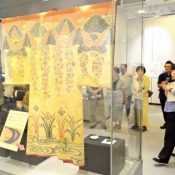
October 6, 2017 by Ryukyu Shimpo
The Okinawa Prefectural Peace Memorial Museum opened their special exhibit, “Okinawan Theater and a World at War – Dreamlike figures of Okinawa,” on October 5 in Itoman.
Using items such as newspaper articles, photographs, and clothing, the exhibit profiles pre-war and wartime cultural censorship and Okinawa’s post-war artistic revitalization.
Admittance is free, and the exhibit will run through December 10.
The exhibit is designed to acknowledge that a peaceful society is linked to respect for cultural identity and freedom of expression.
It shows the darker colors of wartime, and teaches visitors that Okinawan theater was banned.
It also features the article “Flowers Bloom in Scorched Earth,” published by Ryukyu Shimpo.
The exhibit also has on display a costume worn by Ryosho Heiryo, the head of the Bamboo Theater Group, established by the Okinawan Government to help ease those who had been injured in the war.
The costume is made from food sacks from the U.S. military and dyed using anti-malarial medicine to create a bingatastyle pattern.
Exhibit curator Naoko Watanabe, 48, said, “Okinawan theater is steeped in local culture, and I want young people to connect with the things people took great care to protect.”
Ryosho Heiryo’s son, Satoshi, 81, said after seeing the exhibit, “It would be nice if they built an art museum in Uruma, which was the birthplace of the post-war art scene.”
As a related event, on October 29, starting at 2:00 p.m. students from Minatogawa Elementary School in Urasoe and Haebaru High school will be performing plays and dances alongside the exhibit in the exhibition hall.
Additionally, the exhibit will also be on display from January 20 through February 22 at the Yaeyama Peace Museum in Ishigaki.
For more information, call the Okinawa Prefectural Peace Memorial Museum at (+81) 098-997-3844.
(English translation by T&CT and Sam Grieb)
Go to Japanese

October 3, 2017 by Ryukyu Shimpo
An air of nostalgia permeates the Heiwadori shopping arcade in Naha.
The symbol of the area’s shopping district, for years the covered promenade has protected shoppers and the stores they patron from the hot summer sun and the sudden squalls particular to the tropical region.
However, in the 36th year since construction, it continues to show signs of aging, causing issues related to the arcade to pile up.
As such, an informal committee has been formed to consider the options for the arcade.
Ryojun Matsumoto, vice-president of Heiwadori Shopping District Promotion Association (SDPA), said, “The hope is to bring many concerned individuals together to discuss how to further improve Heiwadori.”
The Heiwadori shopping arcade is 416 meters long, 7 meters wide.
It was built in 1981, paid for by the store owners at the time.
While there has been some repairs to parts of the arcade and the renewal of the top covering, the columns and beams are the originals, and continue to deteriorate.
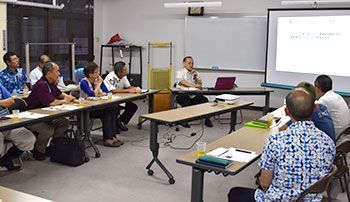
Participants exchanging opinions on what to do with the shopping arcade
With the exception of Sunrise-dori, central shopping streets starting with Heiwadori do not meet many legal standards including building regulations, road-use permits, and fire-safety regulations.
In other cases where shopping arcades underwent renovation, in order to meet the aforementioned standards, additional construction and repairs were needed for the area around the arcade, and costs can exceed 600 million yen.
In 2015, a group to study Heiwadori and other arcades was started, and in 2016 an exploratory committee was established.
However, due to issues such as different property owners and lessees led to low participation, and dialogue could not progress.
Due to this, the SDPA hosted an exploratory committee with a broader group of members on September 28.
Some voiced opinions decrying the 600 million yen cost, saying the arcade should be taken down, while others opposed, claiming if there was no arcade, shoppers would not come. Property managers, store owners, and customers gathered to exchange opinions.
After, they formed a plan to have groups such as the Okinawa Society of Engineers & Building Engineers display simulations of both repairing the arcade and demolishing it, and decide what direction to take within the year.
A representative from the Naha Promotion Association, which was supporting the discussion, commented, “If issues continue to be postponed, they will never be resolved.
Both landlords and store owners need to proactively work towards a solution.”
The next exploratory committee will take place October 26.
(English translation by T&CT and Sam Grieb)
Go to Japanese













 Webcam(Kokusai Street)
Webcam(Kokusai Street)


